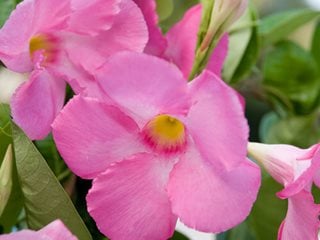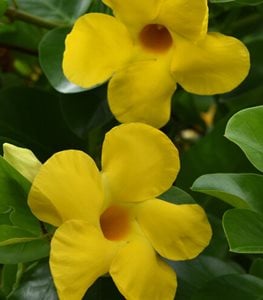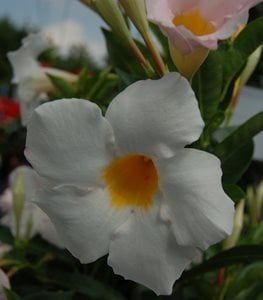HOW TO GROW & CARE FOR MANDEVILLA PLANTS
Bring a touch of the tropics to your landscape with this colorful flowering vine Updated 7/17/2024Mandevilla plants are a stunning addition to any garden, patio, or landscape. Also known as rock trumpet, this tropical vine is prized for its large, showy blooms that appear from late spring to fall. The trumpet-shaped, five-petaled flowers come in vibrant shades of red, white, pink, or yellow, offering a fragrant display that attracts hummingbirds, bees, and butterflies.
Native to Central and South America, mandevilla has become a popular choice for gardeners worldwide. Its versatility makes it an excellent option for containers, perfect for patios and small spaces. This tender perennial adapts well to various climates:
- In frost-free areas, it thrives outdoors year-round
- In colder regions, it can be treated as an annual
- With proper care, it can be overwintered indoors as a houseplant
Growing mandevilla is relatively easy, making it an ideal choice for both novice and experienced gardeners. This low-maintenance vine offers tropical beauty with minimal effort.
On this page: Basics | Planting | Care | Pictures | Frequently Asked Questions | Design Ideas | Mandevilla vs. Dipladenia
On this page:
- BASICS
- PLANTING MANDEVILLA
- MANDEVILLA CARE
- MANDEVILLA VARIETIES
- FREQUENTLY ASKED QUESTIONS
- DESIGN IDEAS
- MANDEVILLA VS. DIPLADENIA
MANDEVILLA BASICS
Botanical name:
Mandevilla spp.
Zones:
8-11
Exposure:
Full to partial sun
Height/Spread:
Vining spreading or bushy habit; 1 to 20 feet tall, 1 to 15 feet wide
Bloom time:
Late spring to fall, with nearly year-round bloom in frost-free climates
Color and characteristics:
This fast-growing tropical vine produces fragrant five-petaled flowers in various shades of pink, red, white, or yellow, some with yellow throats. Oval-shaped glossy green leaves with a smooth or leathery texture grow 2 to 8 inches long. Vining types have a twining habit, benefitting from vertical support. Newer varieties are bred for more shrubby characteristics.
Is mandevilla poisonous?
Mandevilla plant is mildly toxic to children and pets. Cut stems exude a milky sap that can cause skin irritation.
Is mandevilla deer-resistant?
Mandevilla is considered deer resistant, though may be browsed if other food sources are scarce.
HOW TO PLANT MANDEVILLA
When to plant:
Mandevilla can be planted outdoors in mid to late spring after all danger of frost has passed. Wait until nighttime temperatures are 50 degrees F or higher and daytime temperatures reach at least 60 degrees F.
Where to plant:
Plant in a sunny site with rich soil and good drainage.
How to plant:
Loosen soil in the planting area and amend with compost or other rich organic matter. Dig a hole slightly wider and same depth as the root ball. Remove plant from the nursery container and loosen roots if potbound. Place the plant in the hole so the top of the root ball slightly higher than the surrounding soil. Fill in the hole with soil, tamp down gently to remove air pockets, and water thoroughly. Water regularly until established.
MANDEVILLA CARE
Temperature and humidity:
Mandevilla prefers warm temperatures and high air humidity. Optimal temperature range is 68-90 degrees F. In temperatures below 45-50 degrees F, plants may show cold damage. In drier climates, mist plants regularly to boost humidity. Indoors, keep temperatures at 60 to 65 degrees F at night and 70 degrees F or above during the day.
Pruning:
In late winter or early spring, before plants begin producing new growth, cut plants back by up to a third of their size. Remove dead or diseased branches and shape as needed. To encourage a fuller and bushier habit, pinch back stem tips. Plants bloom on new growth, so pruning mandevilla later in the season can result in a loss of flower buds. Mandevilla flowers are self-cleaning, so plants don’t need deadheading.
Soil:
Mandevilla does best in sandy, well-draining soil amended with compost or other rich organic matter and a pH between 6.6 and 7.8. Good drainage is essential to prevent root rot. For containers, use a high-quality, all-purpose potting soil and make sure pots have adequate drainage holes.
Amendments and fertilizer:
Feed plants every two weeks with a slow-release formula, or liquid fertilizer high in phosphorus to promote bloom. Cease fertilizing from fall to early spring if overwintering indoors.
Watering:
Keep soil moist but not soggy. Overwatering can cause root rot or fungal disease. Underwatering can cause plant stress or fewer flowers. Allow soil to dry out somewhat between waterings. Irrigate when the soil surface becomes dry 1 to 2 inches down.
Support:
Mandevilla has a twining habit, needing a free-standing support such as a trellis, pergola, obelisk, or arbor to grow on. The vining branches may need to be tied as they grow to train them in the direction you want them to go.
Pests and diseases:
When grown in optimal conditions outdoors, mandevilla is virtually free of pests and diseases. Plants that are overwintered indoors are more susceptible to pests, including aphids, scale, mealybugs, spider mites, and whitefly. For infestations, apply an insecticidal soap or neem oil according to instructions. Repeat as necessary.
Diseases include root rot, powdery mildew, anthracnose, leaf spot, botrytis, fusarium rot, Southern wilt, and crown gall.
Overwintering:
When outdoor temperatures drop to 50 degrees, bring plants indoors for the winter. Place in a window with bright indirect light and cease fertilizing. Don’t overwater and check each plant carefully for pests. Move back outdoors when nighttime temperatures are consistently 50 degrees F or warmer.
MANDEVILLA VARIETIES
FREQUENTLY ASKED QUESTIONS
Is mandevilla a perennial?
Mandevillas are perennial in frost-free climates, but can be treated as an annual in colder zones.
Do mandevillas like sun or shade?
This sun lover needs at least 6 to 8 hours of direct sunlight for best flowering. Provide protection from hot afternoon sun in warmer climates to prevent leaf scorch.
Do mandevillas come back every year?
Mandevilla plants will come back every year in frost-free climates. For colder climates, plants can be treated as annuals or overwintered indoors.
Can mandevilla survive winter?
Mandevilla can survive winter outdoors in frost-free climates, but will die in colder areas.
Can mandevilla plants be grown indoors?
Yes, mandevilla plants can be grown indoors with proper care: bright indirect light, warm temperatures (60-70°F), high humidity, and well-draining soil. Indoor mandevillas may bloom less frequently than outdoor plants. For best results, consider moving them outdoors during warm months and bringing them inside for winter.
How fast does mandevilla grow?
With optimal care, this fast growing vine can grow 6 to 8 feet or more in a single season. Plants will remain smaller in containers or hanging baskets.
LANDSCAPE DESIGN IDEAS
For borders and landscapes: Use a bushier variety in mass plantings, in beds or along a deck or patio. Vining types can be grown up a trellis or arbor, as screening or a stand-alone focal point.
For slopes and hillsides: Mass a bushier type along a slope or allow to spill over a rock wall.
For containers: Grow vining or semi-bushy types in hanging baskets, window boxes or containers.
There are many ways of growing mandevilla in your landscape. Here’s how:
- Train a larger vining variety on a lattice style trellis to screen out an unsightly view, or to create privacy on a patio or deck.
- Grow mandevilla vine in a container trained on an obelisk to create a stunning focal point in a courtyard, on a sunny deck or patio.
- Plant a bushy type in a colorful decorative pot and place at your home’s entryway for a welcoming touch.
- Train mandevilla up an arbor or pergola by itself or in combination with other vining plants such as spring or repeat-blooming clematis for continuous flowering from spring until fall.
- Display a bush or vining type in a hanging basket on a porch or shepherd’s hook.
- Line a pathway or sidewalk with shrubby types for a colorful border.
- Bring potted plants indoors for the winter and treat as a houseplant.
MANDEVILLA VS. DIPLADENIA
Dipladenia is a tropical plant often confused with Mandevilla. Though they are closely related, there are differences. Dipladenia has a more compact shrub-like growth habit, with smaller flowers occurring in a wider range of colors including coral and apricot. The foliage of Dipladenia is smoother and shinier, while Mandevilla has longer leaves that are more textured. Sometimes the two are crossed in breeding to produce a new hybrid, with some newer Dipladenia varieties exhibiting vining traits.
Diamantina™ Opal Yellow Dipladenia
This Mandevilla hybrid has a vining habit and sunny yellow flowers.
Sundenia® White
This variety is a Dipladenia hybrid with a more compact growing habit and snowy white flowers.
















